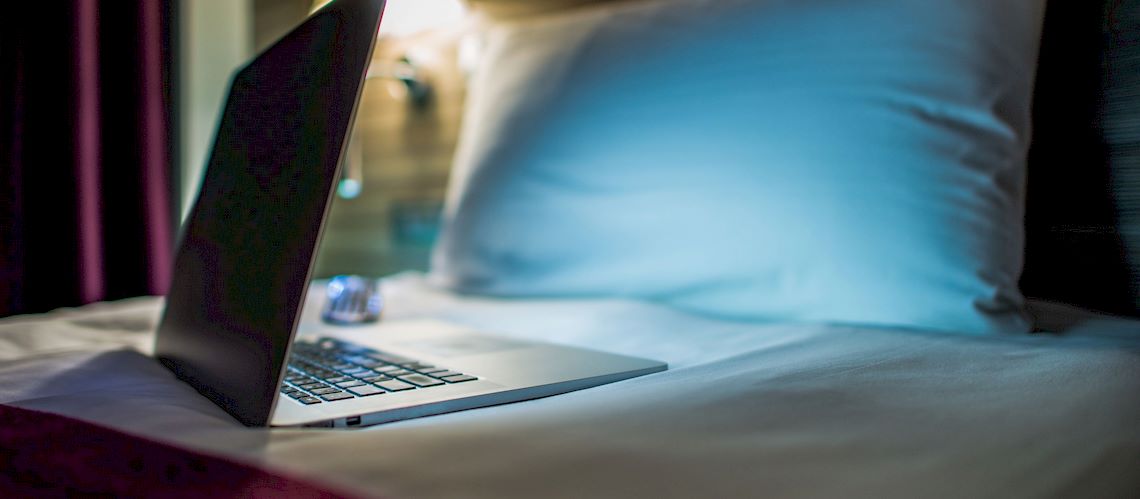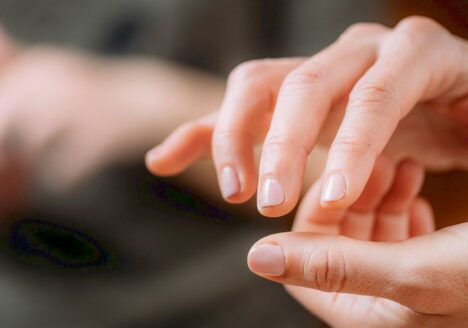In our increasingly digital world, the pervasive use of technology has significant implications for our health, particularly concerning sleep quality and circadian rhythms. Digital curfews and managing blue light exposure have emerged as critical strategies for maintaining healthy sleep patterns and reducing stress. This article integrates findings from authoritative research to explore how implementing digital curfews can enhance sleep, reduce stress, and improve overall well-being.
Definition
A digital curfew involves setting a specific time in the evening to stop using electronic devices, especially those that emit blue light, such as smartphones, tablets, and computers. The primary goal of a digital curfew is to minimize exposure to blue light, which is known to disrupt sleep patterns and circadian rhythms by interfering with the production of melatonin, a hormone essential for sleep regulation (Chang et al., 2015).
History and Origins
The concept of a digital curfew has gained traction with growing awareness of the negative impacts of excessive screen time and blue light exposure on sleep and health. Influential works such as Arianna Huffington’s The Sleep Revolution and Cal Newport’s Digital Minimalism have popularized the idea of setting boundaries with technology to promote better sleep and mental well-being (Huffington, 2016; Newport, 2019). As research on the effects of blue light has evolved, the practice of digital curfews has become more widely recommended by sleep experts and health professionals.
Principles and Concepts
- Blue Light and Melatonin Suppression: Exposure to blue light in the evening can suppress the production of melatonin, a hormone that signals the body to prepare for sleep. This suppression can delay sleep onset, reduce sleep quality, and shorten sleep duration (Gooley et al., 2011; Chang et al., 2015). Devices such as smartphones and tablets emit high levels of blue light, making evening use particularly disruptive to natural sleep patterns.
- Circadian Rhythm Disruption: The body’s circadian rhythms, which regulate sleep-wake cycles, can be significantly disrupted by evening blue light exposure. Disruption of these rhythms is associated with various negative health outcomes, including poor sleep quality, mood disorders, and an increased risk of chronic diseases (Figueiro et al., 2011; Twenge et al., 2018).
- Technology Use and Stress Hormones: The use of electronic devices, particularly before bed, is not only linked to blue light exposure but also to increased levels of stress hormones like cortisol. Continuous engagement with digital content, such as social media or work emails, can elevate stress levels and make it harder to unwind and fall asleep. Elevated cortisol levels are associated with a variety of health issues, including insomnia, anxiety, and decreased immune function (Thomée et al., 2011).
- Digital Detox: Reducing screen time before bed—often referred to as a digital detox—can significantly improve sleep quality and mental health. By avoiding screens in the evening, the body’s natural circadian rhythms can function more effectively, leading to better sleep and reduced stress (Exelmans & Van den Bulck, 2016; Newport, 2019).
Benefits
- Improved Sleep Quality: Implementing a digital curfew helps synchronize the body’s natural circadian rhythms, leading to enhanced sleep quality and duration. Research shows that reducing blue light exposure before bedtime can lead to better sleep efficiency and a shorter time to fall asleep (Chang et al., 2015).
- Reduced Stress Levels: Limiting evening technology use can decrease the secretion of stress hormones, such as cortisol, leading to lower stress levels and a more relaxed state conducive to sleep (Thomée et al., 2011). This reduction in stress also contributes to overall mental well-being and resilience.
- Enhanced Mental and Physical Health: Quality sleep is foundational to good health. By maintaining regular sleep patterns through digital curfews, individuals can reduce their risk of chronic conditions such as obesity, diabetes, and cardiovascular disease, while also improving mood and cognitive function (Figueiro et al., 2011).
Applications
- Personal Health: Individuals can establish digital curfews to enhance their sleep hygiene and overall health, helping to protect their circadian rhythms and reduce stress.
- Family Practices: Families can adopt digital curfews to improve sleep and well-being for all members, creating a healthier home environment.
- Work-Life Balance: Professionals can benefit from reduced evening screen time, leading to better work-life balance, increased productivity, and lower stress levels. By disconnecting from work-related digital content in the evening, individuals can improve both their sleep and their overall quality of life.
Scientific Evidence
Extensive research supports the importance of managing blue light exposure and limiting evening technology use for better sleep and health. Gooley et al. (2011) found that exposure to room light before bedtime suppresses melatonin onset and shortens its duration, which can impair sleep quality. Chang et al. (2015) demonstrated that evening use of light-emitting e-readers negatively affects sleep, circadian timing, and next-morning alertness. Additionally, Figueiro et al. (2011) highlighted the significant impact of blue light emission on sleep quality and circadian rhythm disruption. Moreover, Thomée et al. (2011) showed that frequent mobile phone use is linked to increased stress and sleep disturbances, underscoring the importance of managing screen time to protect mental health.
How to Get Started
- Set a Digital Curfew: Establish a specific time each evening to stop using electronic devices, ideally at least one hour before bedtime. This allows your body to prepare for sleep without the interference of blue light.
- Use Blue Light Filters: Install blue light filters on your devices or use blue light blocking glasses, particularly in the evening, to minimize exposure.
- Create a Relaxing Evening Routine: Replace screen time with relaxing activities such as reading a physical book, meditating, or journaling. These activities can help you unwind and prepare your mind and body for sleep.
- Monitor Your Sleep: Keep track of your sleep patterns using a journal or a sleep app to observe the benefits of reduced blue light exposure and adjusted circadian rhythms. This can help you fine-tune your digital curfew for optimal results.
Case Studies or Testimonials
Numerous studies and anecdotal reports indicate significant improvements in sleep quality and mental health following the implementation of digital curfews. For example, Exelmans and Van den Bulck (2016) found that adults who reduced bedtime mobile phone use reported better sleep quality and fewer sleep disturbances. Similarly, Twenge et al. (2018) observed that adolescents who limited screen time experienced longer sleep duration and improved sleep quality, which correlated with better mood and academic performance. These findings align with personal testimonials from individuals who report enhanced work-life balance, reduced stress, and improved overall well-being after adopting digital curfews.
Conclusion
Digital curfews are an effective tool for enhancing sleep and overall health. By reducing evening blue light exposure and managing technology use, individuals can maintain healthy circadian rhythms, reduce stress, and improve both mental and physical health. Incorporating these practices into daily life can lead to profound improvements in well-being and quality of life.
References
- Chang, A. M., Aeschbach, D., Duffy, J. F., & Czeisler, C. A. (2015). Evening use of light-emitting eReaders negatively affects sleep, circadian timing, and next-morning alertness. Proceedings of the National Academy of Sciences, 112(4), 1232-1237.
- Exelmans, L., & Van den Bulck, J. (2016). Bedtime mobile phone use and sleep in adults. Social Science & Medicine, 148, 93-101.
- Figueiro, M. G., Wood, B., Plitnick, B., & Rea, M. S. (2011). The impact of light from computer monitors on melatonin levels in college students. Neuro Endocrinology Letters, 32(2), 158-163.
- Gooley, J. J., Chamberlain, K., Smith, K. A., Khalsa, S. B., Rajaratnam, S. M., Van Reen, E., … & Lockley, S. W. (2011). Exposure to room light before bedtime suppresses melatonin onset and shortens melatonin duration in humans. The Journal of Clinical Endocrinology & Metabolism, 96(3), E463-E472.
- Huffington, A. (2016). The Sleep Revolution: Transforming Your Life, One Night at a Time. Harmony.
- Newport, C. (2019). Digital Minimalism: Choosing a Focused Life in a Noisy World. Portfolio.
- Thomée, S., Härenstam, A., & Hagberg, M. (2011). Mobile phone use and stress, sleep disturbances, and symptoms of depression among young adults – A prospective cohort study. BMC Public Health, 11, 66.
- Twenge, J. M., Krizan, Z., & Hisler, G. (2018). Associations between screen time and sleep duration are primarily driven by portable electronic devices: Evidence from a population-based study of US children and adolescents. Sleep Medicine, 47, 42-49.




